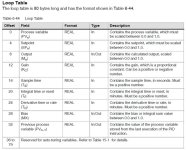Hi, I'm new to this forum and have been programming plc's for about 2 years now. I have done programming and mods on different small systems and know my way around rslogix 500. I'm now working with a s7-200 CPU and a analog module em235 in siemens' micro/win app for the first time. I'm also working with PID loops for the first time. I am working off-site for now and will have some time to go on site to test/diagnostic and tune later on.
My main objective here is to control a VFD driving a pump. I have a 4-20ma pressure transducer on the suction and discharge side of the pump. This pump is acting as a booster for a domestic water system with the city pushing around 75 psi. I have to program the plc so that when high demands come, the pump will compensate the pressure drop and flow increase proportinnally with the pump speed.
From all the docs I've read on siemens' website and other sources I am starting to understand the need for a pid loop. I am also familiar with derivatives and integrals. I've been able to create a PID loop using the included wizard but I have some troubles with implementing the pid loop in the ladder.
Up to now, I've made the basic ladders for the controls. I have put the discharge transducer values as pid scaled input data with a set point at 75 psi. I'm not too sure how to use the output data from the pid loop to control the start/stop and speed of the VFD to compensate for pressure drops and increased flow. I thought of using a scale instruction to change the 0-100% VFD speed(used as values in the ladders) to integer values(6400-32000) that the output analog module can relate to but not sure how to do this while controlling the VFD start contact with the pid output.
The VFD is controlled through a single contact (high=run,low=stop) and there is also a 4-20ma analog input to control speed from 0-100%. The drive will be configured to have a minimum value of 30% to keep the pump well lubricated and cooled when running at low speed.
I hope I haven't asked to much...And that what I am explaining makes any sense.
Feel free to ask me any questions to make this clear.
Thanks!
My main objective here is to control a VFD driving a pump. I have a 4-20ma pressure transducer on the suction and discharge side of the pump. This pump is acting as a booster for a domestic water system with the city pushing around 75 psi. I have to program the plc so that when high demands come, the pump will compensate the pressure drop and flow increase proportinnally with the pump speed.
From all the docs I've read on siemens' website and other sources I am starting to understand the need for a pid loop. I am also familiar with derivatives and integrals. I've been able to create a PID loop using the included wizard but I have some troubles with implementing the pid loop in the ladder.
Up to now, I've made the basic ladders for the controls. I have put the discharge transducer values as pid scaled input data with a set point at 75 psi. I'm not too sure how to use the output data from the pid loop to control the start/stop and speed of the VFD to compensate for pressure drops and increased flow. I thought of using a scale instruction to change the 0-100% VFD speed(used as values in the ladders) to integer values(6400-32000) that the output analog module can relate to but not sure how to do this while controlling the VFD start contact with the pid output.
The VFD is controlled through a single contact (high=run,low=stop) and there is also a 4-20ma analog input to control speed from 0-100%. The drive will be configured to have a minimum value of 30% to keep the pump well lubricated and cooled when running at low speed.
I hope I haven't asked to much...And that what I am explaining makes any sense.
Feel free to ask me any questions to make this clear.
Thanks!




